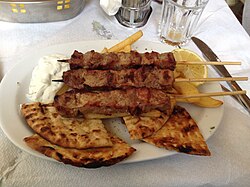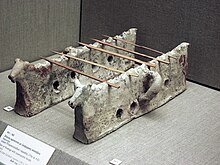Souvlaki - Simple English Wikipedia, the free encyclopedia
 Souvlaki in Athens, known there also as kalamaki (καλαμάκι meaning "small reed") | |
| Type | Fast food |
|---|---|
| Place of origin | Greece |
| Associated national cuisine | Greece |
| Main ingredients | Various meats |
Souvlaki (Greek: σουβλάκι, souvláki, [suˈvlaci]; plural: σουβλάκια, souvlákia) is a Greek food made up of small pieces of meat and sometimes vegetables grilled on a skewer or spit. It is often eaten straight off the skewer while still hot. Souvlaki can be served with or inside a rolled pita, typically with lemon, sauces, vegetables like sliced tomato and onion, and fried potatoes. The meats used are pork, chicken, beef, and lamb.
Name
[change | change source]The word souvlaki is a diminutive of the Greek word souvla (σούβλα meaning "skewer") itself borrowed from the Latin word subula.[1][2]
History
[change | change source]
In Greek culture, the cooking of meat on skewers goes back to the Bronze Age.[3] Sets of cooking supports made of stone were found on the Greek island of Santorini.[4] They were used by the natives to cook souvlaki, "a popular delicacy in Santorini back in 2000 BC", before the volcanic eruption on the island of Thera in the 17th century BC.[4] There are dents in the stone cooking supports likely used for holding skewers and the line of holes in the base allowed the coals to be supplied with air.[5]
In Mycenaean Greece, "souvlaki trays" were found in Gla, Mycenae, and Pylos.[3] The "souvlaki trays", or portable grills, used by the Mycenaean Greeks were rectangular ceramic pans that sat below skewers of meat.[3] It is unclear whether these trays were put directly over a fire or if the pans held hot coals like a portable barbecue pit.[3][6] Spit supports used for cooking food appear to "continue in use into the Early Iron Age at Nichoria."[3] In Greek literature, the Iliad of Homer mentions pieces of meat cooked on spits called obelos (ὀβελός).[7] Obelos is also mentioned in the works of Aristophanes,[8] Xenophon,[9] Aristotle,[10] and others.[11][12] In Classical Greece, a small spit or skewer was called an obeliskos (ὀβελίσκος).[13] Aristophanes mentions such small skewers being used to cook birds.[14]
In the Byzantine Empire, the Greek author of the Prodromic Poems (4.231) mentions "the hot meat shops" of Constantinople giving customers slices of meat cooked on spits like souvlaki called psenasis souglitarea.[15]
In modern times, the French traveler Gustave Flaubert saw Greeks "grilling pieces of meat on a bamboo stick" when he visited the Greek countryside of Boeotia in 1850.[16] But modern souvlaki was not widespread in Greece until after World War II.[16] Souvlaki skewers served as fast food began to be sold widely in the 1960s after their introduction by sellers from Boeotia.[16] The word souvlaki in the English language was first used in 1942.[17]
Gallery
[change | change source]- Souvlaki take-out platters.
- Chicken souvlaki pita served with French fries in a restaurant in the United States.
Related pages
[change | change source]References
[change | change source]Citations
[change | change source]- ↑ Georgios Babiniotis, Λεξικό της Νεας Ελληνικής Γλώσσας, s.v.; Andriotis et al., Λεξικό της Κοινής Νεοελληνικής, s.v. σουβλάκι, s.v. σούβλα
- ↑ Sophocles 2004, p. 1000.
- ↑ 3.0 3.1 3.2 3.3 3.4 Hruby 2017, "Souvlaki trays", pp. 23–25.
- ↑ 4.0 4.1 Eptakili, Tassoula (9 October 2015). "Prehistoric Gastronomy: Dietary habits of a long-lost era". Greece Is. Retrieved 21 February 2016.
- ↑ Utilitarian terracotta object, Museum of Cycladic Culture, Akrotiri excavation artifacts, Santorini, Cyclades, Hellas (Greece).
- ↑ Gannon, Megan (8 January 2014). "Ancient Greeks Used Portable Grills at Their Picnics". Live Science. Retrieved 5 February 2020.
- ↑ Homer. Iliad, 1.465.
- ↑ Aristophanes. Acharnians 1007, Clouds 178, Wasps 354, Birds 388, 672.
- ↑ Xenophon. Hellenica, HG3.3.7.
- ↑ Aristotle. Politics, 1324b19.
- ↑ Homer. Iliad, 1.465.
- ↑ Wright 1999, p. 333.
- ↑ Liddell & Scott 1940: ὀβελίσκος, diminutive of ὀβελός (obelos).
- ↑ Aristophanes. Acharnians, 1007.
- ↑ Dalby 2010, pp. 70, 225.
- ↑ 16.0 16.1 16.2 Matalas & Yannakoulia 2000, p. 6 including footnote 8.
- ↑ "Souvlaki". Merriam-Webster. Retrieved 5 February 2020.
Sources
[change | change source]- Bonanos, Christopher (2005). Gods, Heroes, and Philosophers: A Celebration of all Things Greek. New York: Citadel Press (Kensington Publishing Corp.). ISBN 9780806536811.
- Dalby, Andrew (2010). Tastes of Byzantium. London and New York: I.B. Tauris & Co. Limited. ISBN 9781848851658.
- Gold, David L. (2009). Studies in Etymology and Etiology With Emphasis on Germanic, Jewish, Romance and Slavic Languages. San Vincente de Raspeig: Universidad de Alicante. ISBN 9788479085179.
- Hruby, Julie (2017). "3 Finding haute cuisine: Identifying shifts in food styles from cooking vessels". In Hruby, Julie; Trusty, Debra (eds.). From Cooking Vessels to Cultural Practices in the Late Bronze Age Aegean. Oxford and Philadelphia: Oxbow Books. pp. 15–26. ISBN 9781785706325.
- Liddell, Henry George; Scott, Robert (1940). A Greek-English Lexicon. Oxford: Clarendon Press.
- Matalas, Antonia-Leda; Yannakoulia, Mary (2000). "Greek Street Food Vending: An Old Habit Turned New". In Simopoulos, Artemis P.; Bhat, Ramesh Venkataramana (eds.). Street Foods. Basel (Switzerland): Karger. pp. 1‒24. ISBN 9783805569279.
- Sophocles, Evangelinus Apostolides (2004) [1888]. Greek Lexicon of the Roman and Byzantine Periods (From B. C. 146 to A. D. 1100). Athens: Pelekanos Books. ISBN 9789604007257.
- Wright, Clifford A. (1999). A Mediterranean Feast. New York: William Morrow. ISBN 9780688153052.
Other websites
[change | change source]- "How to Cook Like a Mycenaean". Archaeology Magazine. Archaeological Institute of America. 9 January 2014. Archived from the original on 2 February 2014. Retrieved 5 February 2020.


 French
French Deutsch
Deutsch
